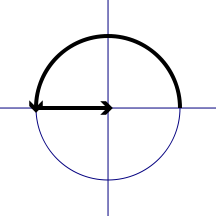| Revision as of 09:25, 30 January 2006 editMelchoir (talk | contribs)Extended confirmed users32,110 editsmNo edit summary← Previous edit | Revision as of 11:23, 31 January 2006 edit undo81.103.145.85 (talk) →Derivation: Reverted; see Discussion.Next edit → | ||
| Line 12: | Line 12: | ||
| ==Derivation== | ==Derivation== | ||
| The equation appears in ]'s ''Introductio'', published in ] in ]. |
The equation appears in ]'s ''Introductio'', published in ] in ]. The identity is a special case of ] from ], which states that | ||
| : <math>e^{ix} = \cos x + i \sin x \,\!</math> | : <math>e^{ix} = \cos x + i \sin x \,\!</math> | ||
| for any ] ''x''. |
for any ] ''x''. If <math>x = \pi\,\!</math>, then | ||
| : <math>e^{i \pi} = |
: <math>e^{i \pi} = \cos \pi + i \sin \pi \,\!</math> | ||
| and since <math>\cos \pi = -1\,\!</math> and <math>\sin \pi = 0\,\!</math>, it follows that | |||
| ⚫ | which |
||
| : <math>e^{i \pi} = -1 \,\!</math> | |||
| ⚫ | which gives the identity. | ||
| ==Perceptions of the identity== | ==Perceptions of the identity== | ||
Revision as of 11:23, 31 January 2006

- For other meanings, see Euler function (disambiguation)
In mathematical analysis, Euler's identity is the equation
where
- is Euler's number, the base of the natural logarithm,
- is the imaginary unit, one of the two complex numbers whose square is negative one (the other is ), and
- is Pi, the ratio of the circumference of a circle to its diameter.
Derivation
The equation appears in Leonhard Euler's Introductio, published in Lausanne in 1748. The identity is a special case of Euler's formula from complex analysis, which states that
for any real number x. If , then
and since and , it follows that
which gives the identity.
Perceptions of the identity
Many people find this identity remarkable for its mathematical beauty. The identity links what are arguably the most fundamental mathematical constants:
- The number 0.
- The number 1.
- The number π is a fundamental constant of trigonometry, Euclidean geometry, and mathematical analysis.
- The number e is fundamental in the study of logarithms and occurs widely in mathematical analysis.
- The imaginary unit i (where i = −1) is a unit in the complex numbers. (Introducing this unit yields all non-constant polynomial equations soluble in the field of complex numbers: see fundamental theorem of algebra.)
Furthermore, the most fundamental functions of arithmetic are also present exactly once: addition, multiplication, and exponentiation. As well, an equation with zero on one side is the most fundamental relation in mathematics.
Benjamin Peirce, the noted nineteenth century mathematician and Harvard professor, after proving the identity in a lecture, said, "It is absolutely paradoxical; we cannot understand it, and we don't know what it means, but we have proved it, and therefore we know it must be the truth."(refactored from Maor)
References
- Maor, Eli, e: The Story of a number (Princeton University Press, 1998), ISBN 0691058547
Notes
Template:Ent Maor, p. 160. Maor cites Edward Kasner and James Newman's, Mathematics and the Imagination (New York: Simon and Schuster, 1940), pp. 103–104, as the source for this quote.

 is
is  is the
is the  ), and
), and is
is 
 , then
, then

 and
and  , it follows that
, it follows that
